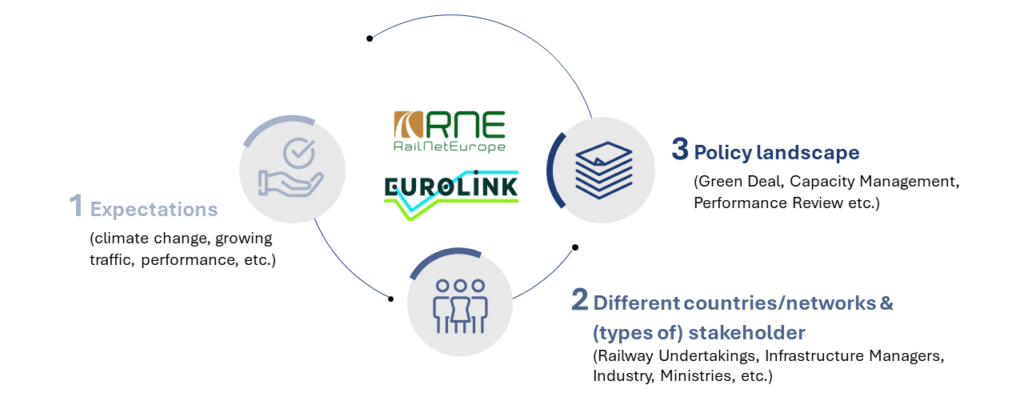Starting as a timetabling expert Think Tank on Capacity Concepts, EuroLink evolved to become a part of RNE as a Working Group.
This was proposed at the RNE General Assembly on 16 May 2024 and confirmed by EuroLink’s all-members meeting on 6 June 2024. The kick-off of regular working group meetings was in December 2024.
As a result, the scope, work plan and progress will be monitored by the RNE management structure.
Chairperson:
Matthieu Maeselle: RNE Chairperson to the EuroLink Working Group and advisor to the Joint Office Capacity Management team.
The Working Group will be also co-chaired by a member of the group on a rotating basis.
Necessary Concepts for Passenger and Freight Traffic
European goals to grow both passenger and freight traffic are ambitious, demanding not only processes but also concepts to be developed for the better use of railway infrastructure.

Mission Statement of EuroLink
The future of Europe’s green mobility is electrified railways. EuroLink aims to contribute to the Green Deal by enabling growth of cross-European train travel.
Competitive cross-European train paths require more than harmonising national paths at the borders, while currently there is no stakeholder advocating for a complete rail capacity concept containing the best possible cross-European train paths. Therefore, the mission of RNE’s new Working Group EuroLink is to unlock market growth by developing concepts for a European optimum of capacity planning. These concepts can be then taken into account in the advance capacity planning process implemented in the context of the Timetable Redesign (TTR) programme.
Principles & Unique Selling Propositions (USPs)

EuroLink follows the principle to plan cross-border long-distance passenger and freight services first, with consideration of the capacity and timetable needs of urban and regional services. By combining different, currently nationally approached strategic planning frameworks (such as the symmetric clock-face timetable) and continuous monitoring of market needs, the goal is to enable the planning of cross-border train paths node-to-node instead of the current international practice of border-to-border.
EuroLink is the most experienced European player in elaborating comprehensive, detailed multi-network freight and passenger rail capacity and timetable concepts on a strategic time horizon.

Future Scoping of EuroLink
EuroLink’s offers several unique selling propositions. Its concepts will enable decision-makers to design and utilise rail network capacity as efficiently as possible.
| Strategic Planning | EuroLink’s concepts take a long-term view, looking at least seven years ahead, to align national capacity and infrastructure strategies toward a coordinated European approach. |
| Holistic Approach | Focus on cross-border rail passenger and freight services connecting major European hubs, while also considering domestic rail services for a comprehensive capacity use concept. |
| Market-Oriented | Concepts are influenced by customer needs and requirements, with ongoing collaborative exchanges with market organisations and channelling in market studies. |
| Results-Driven | Development of Capacity Concepts as non-binding references for identifying ways to better utilise available capacities and pinpointing capacity bottlenecks. |
| Decision-Maker Focused | Reference concepts are aimed at Infrastructure Managers (IMs) and Ministries of Transport (MoTs) to enable them make better decisions on capacity strategies and infrastructure investments. |
| Flexible and Up-to-Date | EuroLink supports RNE in potential future roles, including as a Network Coordinator, amid ongoing EU Rail Capacity Regulation discussions. |
Expected Key Outcomes of EuroLink
As a pan-European integrated capacity concept for cross-border / long-distance services, it is based on overall market needs and available to all operators.
EuroLink can enable in the future swift responses to cross-border requests without compromising the needs of urban and regional services. Furthermore, EuroLink contributes to achieve the EU Green Deal goal of tripling passenger volumes and doubling freight volumes by 2050 by offering a perspective (reaching well into the 2030s) on how to facilitate more cross-border traffic on the European rail network.